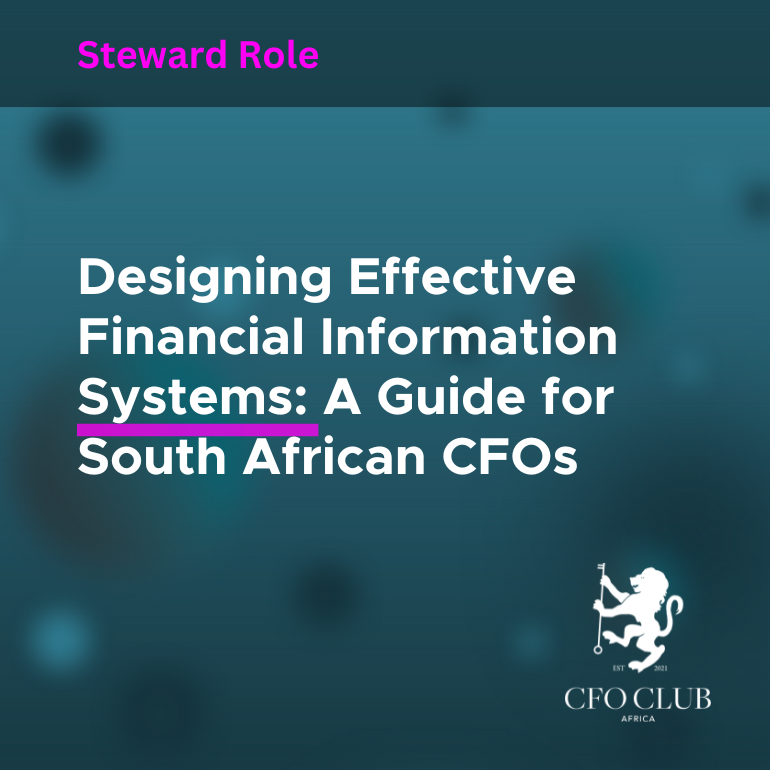Designing Effective Financial Information Systems: A Guide for South African CFOs
In the ever-changing financial landscape, the strength of your financial information system (FIS) plays an important role in determining your organisation’s success. As a CFO in South Africa, you are not only tasked with managing financial performance but also ensuring that your systems are sturdy, compliant, and aligned with both current needs and future growth. This article provides a practical guide to designing an FIS that can meet these challenges head-on.
Understanding Organisational Needs
The foundation of any effective FIS begins with a deep understanding of your organisation’s unique requirements. It’s essential to engage with various stakeholders—including finance teams, auditors, and even IT professionals—to identify the specific needs that your system must address. Whether it’s streamlining financial reporting, enhancing data accuracy, or ensuring compliance with South African regulatory standards, clearly defining these objectives will guide the entire design process.
Choosing the Right Software and Technology
Selecting the appropriate financial software is a critical decision. The South African market offers a range of solutions, from cloud-based platforms that offer flexibility and scalability to on-premises systems that provide greater control and customization. The key is to choose a solution that aligns with your organisation’s size, complexity, and industry-specific requirements. Considerations should include integration capabilities with existing systems, user-friendliness, and the level of vendor support available.
Ensuring Data Integration
In today’s interconnected world, your FIS must seamlessly integrate with other business systems, such as Enterprise Resource Planning (ERP), Customer Relationship Management (CRM), and Human Resources (HR) systems. This interoperability ensures that financial data is consistently and accurately reflected across all departments, providing a unified view that supports better decision-making. Additionally, implementing data validation processes is crucial to maintaining the integrity of the data flowing through these interconnected systems.
Focusing on Security and Compliance
Data security is non-negotiable in any FIS, especially given the increasing risks of cyber threats and the stringent requirements of South African regulations. Implementing robust security measures, such as encryption, access controls, and regular audits, is essential to protect sensitive financial information. Moreover, your system must be designed to comply with relevant financial regulations and standards, such as the International Financial Reporting Standards (IFRS), Generally Accepted Accounting Practice (GAAP), and local tax laws. Regular updates to the system to reflect changes in these regulations are also crucial.
Designing User-Friendly Interfaces
The effectiveness of an FIS is also determined by how easily users can interact with it. A user-friendly interface can significantly reduce the learning curve and increase the system’s adoption rate among your finance team. Dashboards should be intuitive and customizable, allowing different users to access the specific data and reports they need quickly. This not only improves efficiency but also empowers your team to focus on more strategic tasks.
Automating Processes
Automation is a powerful tool in modern FIS design. By automating routine tasks like data entry, reconciliations, and report generation, you can minimize the risk of human error and free up valuable time for your team to focus on strategic analysis. Moreover, implementing real-time data processing capabilities can provide your organisation with up-to-date financial insights, enabling more responsive and informed decision-making.
Implementing Strong Data Management Practices
Data quality is the backbone of an effective FIS. Establishing strong data management practices, including regular data cleansing and validation, ensures that your financial information remains accurate and reliable. Additionally, developing a comprehensive data backup and disaster recovery plan is essential to safeguard against data loss and ensure business continuity in the event of a system failure.
Training and Supporting Users
No system, no matter how well designed, can be effective without proper user training. Providing comprehensive training programs for all users of the FIS ensures that they can utilize the system to its full potential. Additionally, establishing a dedicated support team or helpdesk can help users resolve any issues they encounter, ensuring that the system continues to operate smoothly.
Monitoring and Optimizing the System
The work doesn’t stop once the FIS is up and running. Continuous monitoring of the system’s performance is essential to identify any bottlenecks or areas for improvement. Utilizing analytics to assess how well the system meets your organisation’s goals can provide valuable insights for ongoing optimization. Regular updates and improvements based on user feedback and technological advancements will keep your FIS agile and effective in a changing financial landscape.
Planning for Scalability
Finally, it’s crucial to design your FIS with the future in mind. As your organisation grows, your financial information system must be able to scale with it. This might involve expanding the system’s capacity, integrating new functionalities, or even migrating to a more advanced platform. By planning for scalability from the outset, you can ensure that your FIS remains relevant and effective, supporting your organisation’s long-term financial health and success.
Conclusion
Designing an effective financial information system is a complex but essential task for CFOs in South Africa. By focusing on organisational needs, choosing the right technology, ensuring data integration and security, and planning for the future, you can create an FIS that not only meets your current requirements but also supports your organisation’s strategic goals. Remember, the effectiveness of your FIS is not just about the technology; it’s about how well it aligns with your organisation’s objectives and how effectively it is used by your team.

